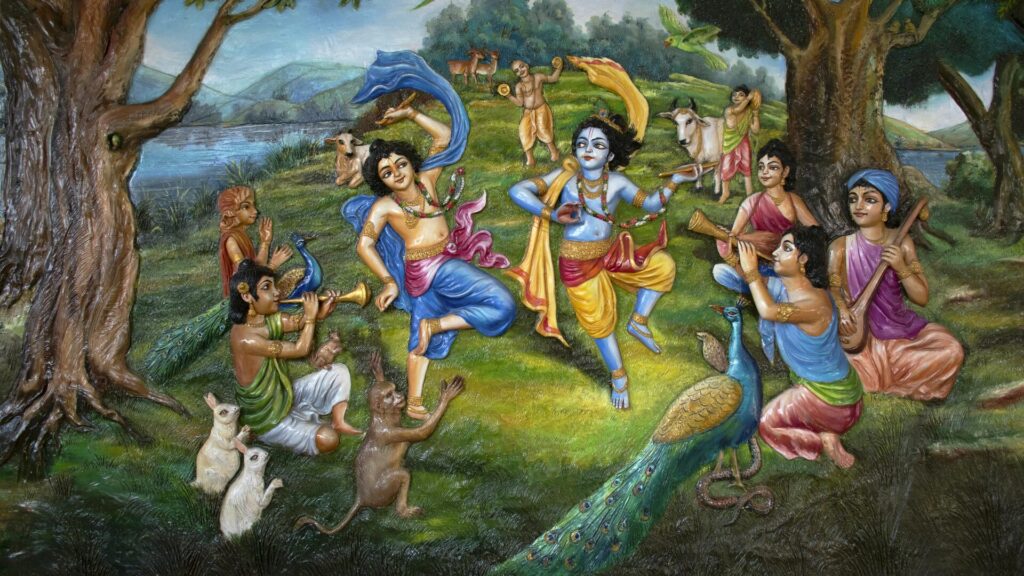
Introduction
Krishna, the eighth incarnation of Vishnu, is one of the most revered deities in Hinduism. Krishna is widely known to be god of love, compassion, tenderness and protection. The anecdotes and narratives of Krishna’s life are generally titled as Krishna Lila. He is a central figure in the Mahabharata, the Bhagavata Purana, the Brahma Vaivarta Purana, and the Bhagavad Gita, and is mentioned in many Hindu philosophical, theological, and mythological texts. Krishna is represented in multiple roles. Yashoda’s son who steals butter, the notorious kid who teases the Gopis, the warrior who kills Kansa and many other evil beings, the philosopher who guides Arjuna, the savior who stand by Draupadi, the statesman who tries for peace between Kauravas and Pandavas, the ruler of Mathura and later Dwaraka. Krishna fits with equal ease in each of these roles. Because of the multiple roles he has played, his devotees worship him in multiple roles.
Historical and Literature Sources about Krishna
The name and synonyms of Krishna have been traced to 1st millennium BCE literature and cults. Vasudeva was a hero-god of the Vrishni tribe, that lived in India in 2nd cent BCE. The Vrishni heroes are a group of five legendary, deified heroes who are found in the literature and archaeological sites of ancient India. Their earliest worship is attestable in the clan of the Vrishnis near Mathura by 4th-century BCE. Mathura in incidentally the place also associated with krishna. A coin from this tribe was discovered in Hoshiarpur (today’s Punjab). The coin has a Dhammachakra and Buddhist symbols engraved on it. Also some other coins of Agathocles of Bactria (indo Greek kings from 190-180 BCE) depict the Vrishni heroes. One of them is holding a mace and plow (like Balrama) and other is holding Shankha-Chakra (conch and wheel), just like Krishna. Vrishni triad is also shown in a rock painting at Tikla, Madhya Pradesh (3rd-2nd century BCE). The characters in the rock painting are Samkaraana (with plough and mace), Vasudeva (with mace and wheel) and a female deity, probably Ekanamsha.
At one point in time, it is thought that the tribe of the Vrishnis fused with the tribe of the Yadavas/Abhiras, whose own hero-god was named Krishna. Because of appearance of Buddhism symbols on coins of Vrishni tribe, Krishna is also associated with Buddhism. And because of coins issued by a Indo-Greek empire, that depict Krishna, Krishna is often said to have an influence in the Greek mythology too.
The Heliodorus Pillar, a stone pillar with a Brahmi script inscription, was discovered by colonial era archaeologists in Besnagar (Vidisha, in the central Indian state of Madhya Pradesh). Based on the internal evidence of the inscription, it has been dated to between 125 and 100 BCE. The Heliodorus pillar inscription is a private religious dedication of Heliodorus to “Vāsudeva”, an early deity and another name for Krishna in the Indian tradition. It states that the column was constructed by “the Bhagavata Heliodorus” and that it is a “Garuda pillar” (both are Vishnu-Krishna-related terms). Additionally, the inscription includes a Krishna-related verse from chapter 11.7 of the Mahabharata stating that the path to immortality and heaven is to correctly live a life of three virtues: self-temperance (damah), generosity (cagah or tyaga), and vigilance (apramadah). The Heliodorus pillar site was fully excavated by archaeologists in the 1960s. The effort revealed the brick foundations of a much larger ancient elliptical temple complex with a sanctum, mandapas, and seven additional pillars. The Heliodorus pillar inscriptions and the temple are among the earliest known evidence of Krishna-Vasudeva devotion and Vaishnavism in ancient India.
The Hathibada Ghosundi Inscriptions, all located in the state of Rajasthan and dated by modern methodology to the 1st century BCE, mention Samkarsana and Vasudeva, also mention that the structure was built for their worship in association with the supreme deity Narayana. These four inscriptions are notable for being some of the oldest-known Sanskrit inscriptions. A Mora stone slab found at the Mathura-Vrindavan archaeological site in Uttar Pradesh, held now in the Mathura Museum, has a Brahmi inscription. It is dated to the 1st century CE and mentions the five Vrishni heroes, otherwise known as Samkaraana, Vasudeva, Pradyumna, Aniruddha, and Samba.

The five Vrishni heroes standing around enthroned Narasimha.
Kondamotu Vrishni heroes relief, 4th century CE, Hyderabad State Museum. PC : Vinaykumar Gupta
At the Chilas II archaeological site dated to the first half of the 1st-century CE in northwest Pakistan, near the Afghanistan border, are engraved two males, along with many Buddhist images nearby. The larger of the two males held a plough and club in his two hands. The artwork also has an inscription with it in Kharosthi script, which has been deciphered by scholars as Rama-Krsna, and interpreted as an ancient depiction of the two brothers, Balarama and Krishna.
The first known depiction of the life of Krishna himself comes relatively late, with a relief found in Mathura, and dated to the 1st–2nd century CE. This fragment seems to show Vasudeva, Krishna’s father, carrying baby Krishna in a basket across the Yamuna. The relief shows at one end a seven-hooded Naga crossing a river, where a crocodile is thrashing around, and at the other end a person seemingly holding a basket over his head.
If we talk of the literature sources, The earliest text containing detailed descriptions of Krishna as a personality is the epic Mahabharata, which depicts Krishna as an incarnation of Vishnu. The Chandogya Upanishad (verse III.xvii.6) mentions Krishna in Krishnaya Devakiputraya as a student of the sage Ghora of the Angirasa family. Ghora is identified with Neminatha, the twenty-second tirthankara in Jainism, by some scholars.
Megasthenes, a Greek ethnographer and an ambassador of Seleucus I to the court of Chandragupta Maurya towards the end of 4th century BCE, made reference to Herakles in his famous work Indica. This text is now lost to history, but was quoted in secondary literature by later Greeks such as Arrian, Diodorus, and Strabo. According to these texts, Megasthenes mentioned that the Sourasenoi tribe of India, who worshipped Herakles, had two major cities named Methora and Kleisobora, and a navigable river named the Jobares. According to Edwin Bryant, a professor of Indian religions known for his publications on Krishna, “there is little doubt that the Sourasenoi refers to the Shurasenas, a branch of the Yadu dynasty to which Krishna belonged”. The word Herakles, states Bryant, is likely a Greek phonetic equivalent of Hari-Krishna, as is Methora of Mathura, Kleisobora of Krishnapura, and the Jobares of Jamuna. Later, when Alexander the Great launched his campaign in the northwest Indian subcontinent, his associates recalled that the soldiers of Porus were carrying an image of Herakles.
The Buddhist Pali canon and the Ghata-Jâtaka (No. 454) polemically mention the devotees of Vâsudeva and Baladeva. These texts have many peculiarities and may be a garbled and confused version of the Krishna legends. The texts of Jainism mention these tales as well, also with many peculiarities and different versions, in their legends about Tirthankaras. This inclusion of Krishna-related legends in ancient Buddhist and Jain literature suggests that Krishna theology was existent and important in the religious landscape observed by non-Hindu traditions of ancient India.
Many Puranas tell Krishna’s life story or some highlights from it. Two Puranas, the Bhagavata Purana and the Vishnu Purana, contain the most elaborate telling of Krishna’s story, but the life stories of Krishna in these and other texts vary, and contain significant inconsistencies.
Krishna’s Life and Places Associated
Krishna’s life story is widely known to people of India. The story has been retold multiple times by thousands of speakers or religious figures. It has been displayed through multiple art forms like paintings, dance, literature, sculptures and cinema. And there is very little doubts or paradoxes when it comes to identifying places associated with Krishna’s life.
Krishna was born in a jail, where his father Vasudeva and mother Devki were kept by Kamsa. Kamsa was told that the eighth son born to this couple will be the reason for his death. And hence, he would kill every child that was born to the couple. Today’s Mathura is widely accepted as the place where the jail was situated. Kansa is said to be ruler of Mathura in that time. Today, Mathura has a temple of Krishna, which is known as Krishna Janmasthan Temple Complex. There are three main temples inside the premises — Keshavdev temple which is dedicated to Krishna, Garbh Griha where Krishna is believed to be born in Dvapar Yuga and Bhagvata Bhavan where presiding deities are Radha Krishna. The place has held religious significance since at least the 6th century BCE with findings of religious artifacts in excavations. The temples were destroyed multiple times throughout history, most recently by the Mughal emperor Aurangzeb in 1670. He built the Shahi Eidgah mosque there, which still stands. In the 20th century, the new temple complex adjacent to mosque was built with the financial help from industrialists.
After Krishna was born in the jail, it is said that Nidradevi (the goddess of sleep) casted a spelled on the whole town, because of which, everybody fell asleep. The gates of the jail were opened automatically, for Vasudeva to carry Krishna to a safe place. Vasudeva put Krishna in a basket and carried him across the town and crossed the river Yamuna. There, he exchanged Krishna with another newborn baby, the daughter of Yashoda and Nanda. When Kamsa tries to kill the newborn, the exchanged baby appears as the Hindu goddess Yogamaya, warning him that his death has arrived in his kingdom, and then disappears. Krishna grows up as child of Nanda and Yashoda, along with his two siblings Balrama and Subhadra. The place where Krishna grew up is said to be today’s Vrindavana and Gokul. Gokul is the place where Krishna lived, and Vrindavan is the nearby forest area where Krishna used to often wander along with his cows.
The legends of Krishna’s childhood and youth describe him as a cow-herder, a mischievous boy whose pranks earn him the nickname Makhan Chor (butter thief). The term of Chor (thief) was not limited with the butter though. Many scholars say that the term also described him as a protector who steals the hearts of the people in both Gokul and Vrindavana. In Gokul, Krishna is worshipped as Laddugopal (the Krishna who is favorite of everyone) in the Nand Bhavan temple. Interestingly, the temple is named Nand Bhavan, meaning the house of Nanda. Krishna’s father Nanda is more important in the nomenclature than Krishna himself. In Vrindavan, there is a temple of Banke Bihari. Banke means “the one who is bent in three places”, and Bihari means “the supreme enjoyer”. Krishna has gotten his name because he usually has three bent limbs in his most common standing flute-playing position.
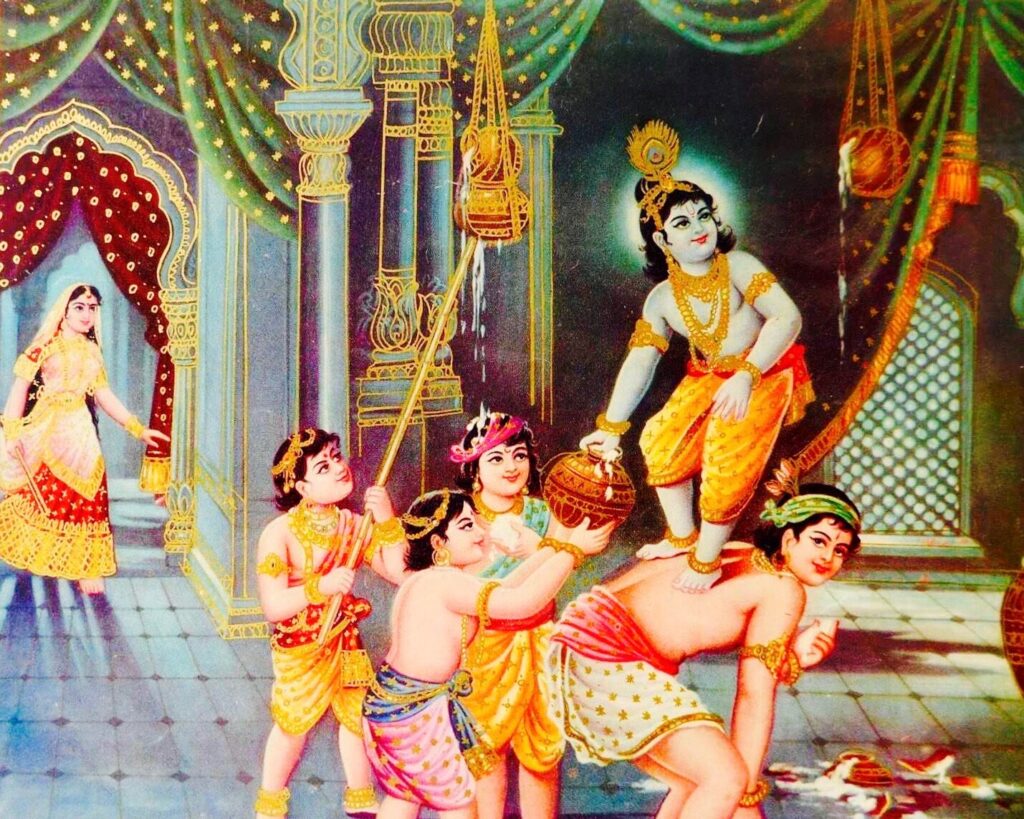
Krishna stealing Butter, one of the most adored Krishna Leela
As Krishna enters into adulthood, he returns to Mathura. He overthrows and kills the cruel king, his maternal uncle Kansa, after quelling several assassination attempts by Kamsa. He reinstates Kamsa’s father, Ugrasena, as the king of the Yadavas and becomes a leading prince at the court. Jarasandha, father-in-law of Kamsa, invaded Mathura with a vast army. In the war, Krishna destroyed his army. But soon after, another asura named Kalayavan surrounded Mathura with another army of thirty million monstrous fiends. This is when Krishna thought it well to depart to Dvaraka. On the way from Mathura to Dwaraka, comes a place named Dakor. Here, Krishna is worshipped as Ranchodrai (the king who fled the warfield). The local folk stories suggest that this name was given to Krishna because he fled from a war in Mathura, to a safe place in Dwaraka.
Later, Krishna appears in story of Mahabharata. He is a friend of Draupadi, and also a distant cousin of the Pandavas. After Draupadi gets married to the five Pandavas, Krishna comes to Hastinapur to meet Draupadi. There he becomes friends with Arjuna and remains with him until the end of the Kurukshetra war. He plays roles of a statesman, a philosopher, a friend and guide at various events in the Mahabharata. At the start of the Kurukshetra War between the Pandavas and the Kauravas, Arjuna despairs thinking about the violence and death the war will cause in the battle against his kin. He becomes emotionally preoccupied with a dilemma. Wondering if he should renounce the war, Arjuna seeks the counsel of Krishna, whose answers and discourse constitute the text of Bhagavad Gita. Krishna is widely worshipped as the narrator of Gita, in multiple temples across India.
In Dwaraka, where Krishna spent his life towards the end of his life, he is worshipped as Dwarakadhish (the king of the Dwaraka). Dwaraka is one of the Char Dhams (Four highly auspicious religious places as mentioned by Shankaracharya). The main shrine of the five-storied building, supported by 72 pillars, is known as Jagat Mandir or Nija Mandir. Archaeological findings suggest the original temple structure existed here in 200 BCE at the earliest. The temple was rebuilt and enlarged in the 15th–16th century. As per many local legends, Krishna, with his powers, reclaimed some land from the sea to build his capital city Dwaraka. After Krishna ended his incarnation, the sea reclaimed what it had offered to Krishna. The original Dwaraka city, built by Krishna, is said to have submerged in the sea. The undersea explorations and excavations have revealed existence of many structures under the sea. The current Dwaraka city was developed later on the sea shore, after the earlier Dwaraka city got submerged.
In Veraval district, close the the town of Prabhas Patan (known for the Jyotirlinga Somnath), is a small village with the name Bhalka. In Bhalka, there is a Krishna temple that is associated with the story of Krishna’s death. In the war of Kurukshetra, Gandhari lost her 100 sons and many other relatives. She was anguished at Krishna for this. Because she believed that Krishna had the power and skills to not let the war happen. She felt Krishna deliberately let the war happen. She cursed Krishna that he will see whole Yadav clan getting killed, in front of his own eyes. Once, while the whole Yadava family was on a pilgrimage, they all drank a lot of wine. And under the influence of wine, they started to fight with each other. And before Krishna could do anything, they all killed each other. When Krishna was sleeping next to a water pond, feeling very sad after demise of his whole clan, a hunter named Jara mistook him to be some animal and he shot arrow at him. The arrow hit Krishna’s thumb of Krishna’s right leg. With this arrow, Krishna left his body and moved to his heavenly abode. Today, a shrine has been built on the bank of an ancient pond in this village. The temple holds beautiful sculpture of Krishna laying down with arrow in his leg, and the hunter Jara is asking for forgiveness.
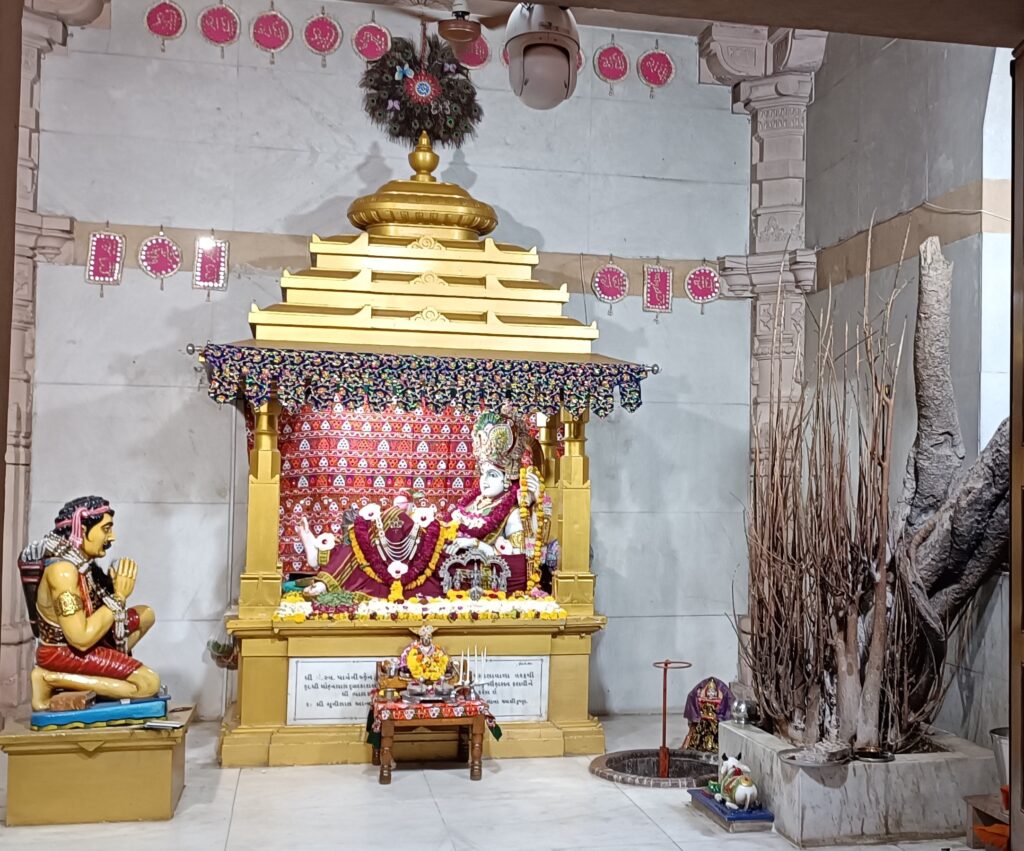
Jara asking for forgivess to Krishna, after his arrow hits Krishna. Bhalaka Teerth, dist Veraval, Gujarat
Krishna Worship at places not associated with his life
Apart from the places associated with Krishna’s life, Krishna is also worshipped at many places in many different forms. And for centuries, this Krishna worship has been a prominent place in the Bhakti movement as well.
Among the four Dhams established by Adi Shankaracharya, we already talked about the Dwaraka earlier. Another Dham located in the snowy mountains of Himalaya is the Badrinath dham. Badri is name for one kind of date that is found in the Himalayan region. The legend says that Vishnu sat in meditation on a rock in Himalaya. He didn’t realise the cold weather there. To protect Vishnu, Lakshmi took form of a Badri tree and grew next to the rock where Vishnu was meditating. Pleased by Lakshmi’s devotion, Vishnu decided to name the place as Badrika Dham or Badrinath. Though this place is a Vishnu shrine, the Vaishnavites associate it with Krishna as well. This is because there is a very thin differentiation line between Vishnu and Krishna. Some researchers have also claimed this to be a Buddhist shrine, later converted into Hindu temple. But there isn’t much evidence suggesting this.
Adi Shankaracharya visited the place in the ninth century and established the idol there. He also built the temple, as per local legends. Prior to his visit, the place is said to have also been visited by Pandavas. Pandavas arrived here towards the end of their life, post Kurukshetra war. In the Garhwal region, there is a folk dance called as “Pandava Nritya” to commemorate visit by Pandavas. This temple remains open only for 6 months, and gets closed for 6 months because of harsh weather. Folklores talk about the deity being worshipped by the Gods for 6 months, when it is closed for humans.
Another Dham, that is associated with Krishna is the Jagannath temple at Puri in Odisha. The temple houses idols of Krishna, Balarama and Subhadra; the three siblings. As per temple records, King Indradyumna of Avanti built the main temple of Jagannath at Puri. The present temple was rebuilt from the tenth century onwards. The rebuilding happened on the site of the pre-existing temples. The reconstruction and expansion was begun by Anantavarman Chodaganga, the first king of the Eastern Ganga dynasty. The inner sanctum of the temple contains the deities of them carved from sacred neem logs, sitting on the bejewelled platform (ratnabedi), along with the deities of Sudarshana Chakra, Madanmohan, Sridevi and Vishwadhatri. The deities are adorned with different clothing and jewels according to the season.
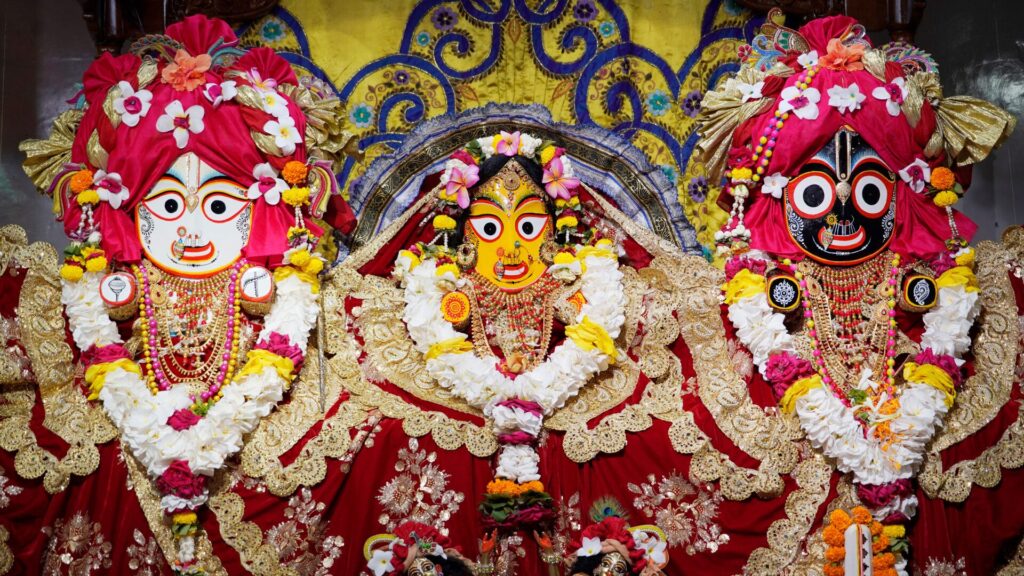
Krishna, Balarama and Subhadra, as part of the Jagannatha tradition
The temple is famous for its annual Ratha Yatra, or chariot festival, in which the three principal deities are pulled on huge and elaborately decorated raths, or temple cars. The worship is performed by the Bhil Sabar tribal priests, as well as priests of other communities in the temple. Unlike the stone and metal icons found in most Hindu temples, the image of Jagannath is made of wood, and is ceremoniously replaced every 12 or 19 years by an exact replica. Nabakalabera is a ritual associated with Jagannath, which takes place every 8, 12 or 19 years. The ritual tkaes place when one lunar month of Ashadha is followed by another lunar month of Ashadha. Meaning “New Body”, the ritual involves installation of new images in the Jagannath Temple and the burial of the old images at the temple at Koili Vaikuntha.
In the neighboring Bengal region, we come across a very beautiful terracotta temple of Radha Madhab at Bishnupur. Radha Madhab temple was built by Churamon Devi, a consort of the Malla king Krishna Singha, in 1737 CE. The temple is specially known for the quality and preservation of the bas-relief carvings, which can be observed on the south and east-facing elevations. These have been elaborately executed, with reliefs containing scenes from Krishnalila, Dasavatara (ten incarnations of Vishnu), Ramayana, Mahabharata, accompanied by elaborate floral designs and depictions of birds and animals.
In the north eastern state of Manipur, Krishna is worshipped by the name Govindajee. At the Shree Govindajee Temple or Shri Shri Govindajee Laishang, Radha Krishna is worshipped. The temple was originally built in 1846 during the reign of Maharaja Nara Singh and later rebuilt by Maharaja Chandrakriti in 1876. during the Anglo Manipur war of 1891 the idols of the temple were moved to Kongma. In 1908, after the Maharaja Churchand Singh took up residence at his new palace the idols were also moved and reconsecrated in the present temple.
In Tamilnadu’s capital Chennai, Krishna is worshipped as Parthsarathy Perumal. Parthasarathy literally means the charioteer of Arjuna. The was originally built by the Pallavas in the 6th century by king Narasimhavarman I. The temple has icons of five forms of Vishnu: Yoga Narasimha, Rama, Gajendra Varadaraja, Ranganatha, and Krishna as Parthasarathy. The temple is one of the oldest structures in Chennai. As per a local legend; during the war between Arjuna and Bhishma at Kurukshetra, Krishna got injured by an arrow shot by Bhishma. The idol at this temple has a mark, as a wound caused by the arrow shot by Bhishma. The place is the only place where the presiding deity is sported with a moustache. The temple was subsequently expanded by Cholas and later by the Vijayanagara kings in the 15th century. Multiple festivals take place in the temple throughout the year.
In neighboring Kerala, Krishna is worshipped as Guruvayurappan at the Guruvayur temple. Here, the central deity is that of four armed Vishnu carrying Shankha, Chakra, Gada and a lotus flower with Tulsi garland. The existence of Tulsi garland in the iconography connects it to Krishna directly. The tale of this temple is connected to king Janmejaya, son of Parikshit from the Pandava clan. Because Parikshit died because of a snake, Janmejaya decided to kill all snakes from the land. But because of this action of killing thousand of snakes, he got infected by leprosy. On advice of sage Atreya, he took refuge at the feet of Krishna here. And because of his worship; he got free from the disease. When he returned to his kingdom, he noticed a snakebite mark on his left leg. He realised that Krishna had saved him from the death twice; and he decided to build a huge temple at Guruvayur. In 18th and 19th century, the temple was destroyed multiple times. Recently, in 1970, a major fire destroyed major parts of the temple. The temple was subsequently rebuilt.
In Karnataka’s Udupi, Udupi Shri Krishna Temple is a well-known historic temple dedicated to Krishna. The Matha area resembles a living Aashram, a holy place for daily devotion and living. The Krishna Matha was founded by the Vaishnavite saint Madhvacharya in the 13th century. He was the founder of the Dvaita school of Vedanta. It is believed that Madhvacharya found the vigraha of Krishna in a large ball of gopichandana. As told by Madhvacharya in his Tantrasara Sangraha, the Vigraha was placed initially in the east direction. Due to intense devotion shown by kanakadasa, the deity is said to have turned Pashchimabhimukha (facing west). During the Paryaya festival, held once every two years, the temple management is handed over to the next Ashta Matha, which has been entrusted the responsibility of running the temple turn by turn. Each of the Mathas is headed by a swami, who will be in charge of the temple during his Paryaya. The Paryaya is held on even years The Paryaya tradition has completed 500 years as of 2021.
In Maharashtra’s Padharpur; Krishna is worshipped in the form of Vitthala or Vithoba. Krishna is said to have appeared here to meet his devotee Pundalika. However, when Krishna came; Pundalika was busy taking care of his parent. He asked Krishna to wait on brick outside his hut, till his parents go to sleep. Pundalika also caught sleep while his parents were sleeping, and he forgot about Krishna standing at the door. Krishna is still standing there, on a brick, with hands on the waist; as if still waiting for a dialogue with Pundalika. This is one of the very rare Vigrahas where the deity is without any weapon in hand or around. Similar sculpture of Vishnu can also be seen in Udaygiri caves in Vidisha. There is also another legnd that says the idol here was earlier the Vijay Vitthala temple in Hampi, and was brought here to save from the attacks of the invadors. Every year, during the Wari festivals, lakhs of pilgrims walk on foot from different parts of the state and visit Pandharpur shrine. Most important of these foot pilgrimages (waris) are the one that start from Alandi and Dehu (both in Pune district).
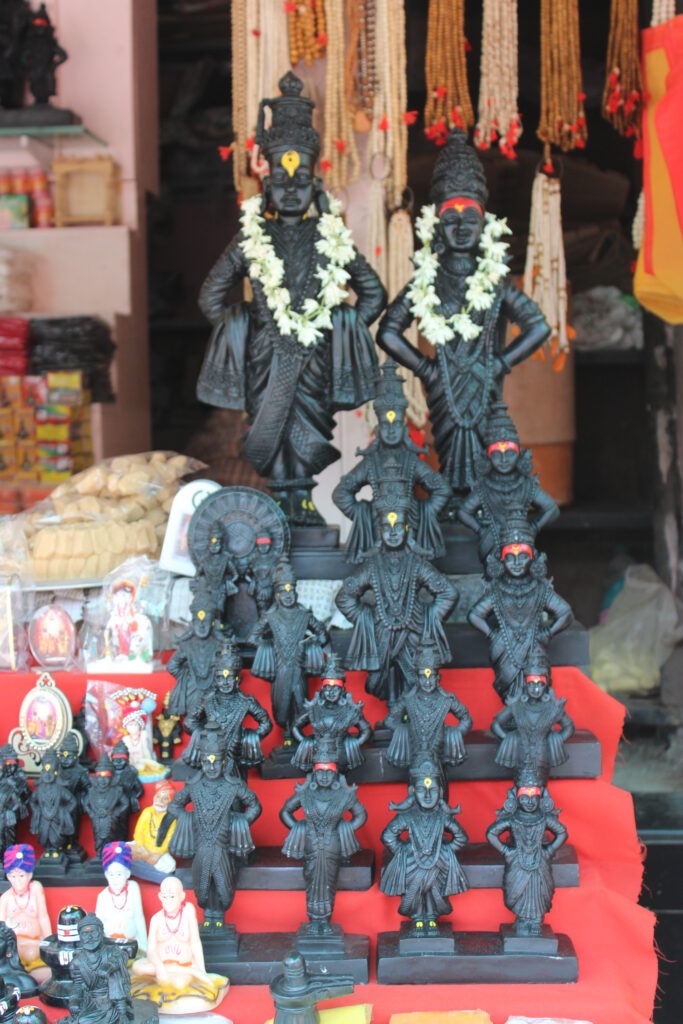
Vitthala (a form of Krishna) with his consort Rukhmini, worshipped in Maharashtra
In Rajashtan’s Nathdwara; there is a temple of Shreenathji. The temple is part of a large Haveli. The Krishna idol here, has left hand raised upword. This is said to be symbolic of the time when Krishna had lifted the Govardhan Parvat, to save the cows in citizen of Gokul from the wrath of Indra. Some legends also talk about connection between this temple and the Dwarakadhish temple in Gujarat. It is said that when foreign invasions were happening, the Vigraha from Dwarakadhish temple was brought here by then kings. Once things settled, the Vigraha was sent back to the original place. But because the Vigraha was worshipped here, the king decided to build a temple for Krishna. The Shingar or dressing of deity here, is changed 7 times a day. To see Krishna in different forms, devotees visit the temple multiple times a day.
At Khatu in Rajasthan, there is a temple of Shyam Baba or Khatunaresh. The main deity here is Barbarika, the grandson of Bhima. He was a formidable warrior known for his invincibility and was in possession of three powerful arrows that could guarantee victory in any battle. The three arrows had special powers: the first one would mark all the things Barbarika wanted to destroy, the second would mark all the things he wanted to save, and the third arrow would simply destroy the targets that had been marked. When Barbarika got to know about the war his granfather was fighting, he went to take part in the war. He assured his mother that he would only intervene on behalf of the side that was losing. However, Krishna realised that whenever Barbarika would join the defeating side, the side would start winning. And then, he would have to shift sides. This way; the war would never end. To prevent total destruction this way, Barbarik sacrificed his head. Krishna, pleased with his bravery and sacrifice, made Barbarika a part of himself. Thus, Barbarika became Shyam (another name for Krishna).
At Ramdevra, near Pokhran in Rajasthan, the folk deity Ramdevji is said to be an incarnation of Dwarkadhish Krishna. The ruler of Pokhran, Ajaymal or Ajmal, had no children. He went to Dwaraka to pray to Krishna for a child. Anguished by the Vigraha not responding, he threw a laddo at Krishna. Afraid of wrath of this king, the priest int he temple told Ajmal that Krishna is resting at the bottom of the sea because of the unbearable summer heat. Ajmal immediately jumped in the sea. There, he met Krishna and Krishna promised him that he himself will come to Ajmal’s home as child. Here, Ramdevji is said to have appeared directly in the swing built for Ajmal’s elder son Biramdev.
Krishna’s influence in the Bhakti Movement
The Bhakti movement was a significant religious movement in medieval Hinduism, that sought to bring religious reforms to all levels of society by adopting the method of devotion to achieve salvation. Originating in Tamilakam during 6th century CE, it gained prominence through the poems and teachings of the Vaishnava Alvars and Shaiva Nayanars before spreading northwards. The Bhakti movement was characterised by a personal relation between deity and the devotee. The alvars in Tamilnadu, who worshipped Vaishnavite shrines like Tirumala, composed songs and literature promoting Vaishnavism. The bhakti movement in Karnataka (12th century) is credited to Madhavacharya who established the Krishna temple at Udupi. Nimbarkacharya, who hailed from Andhra and moved to Vrindavan, took the movement towards the north. Chaitanya Mahaprabhu also expanded the Krishna Bhakti in the northern tegion in the 14th century. In Bengal, the 14th century poet Candidas developed a Bhakti movement surrounding Krishna. Similarly, Vallabhacharya Mahaprabhu expanded the Krishna Bhakti in northern parts of the country.
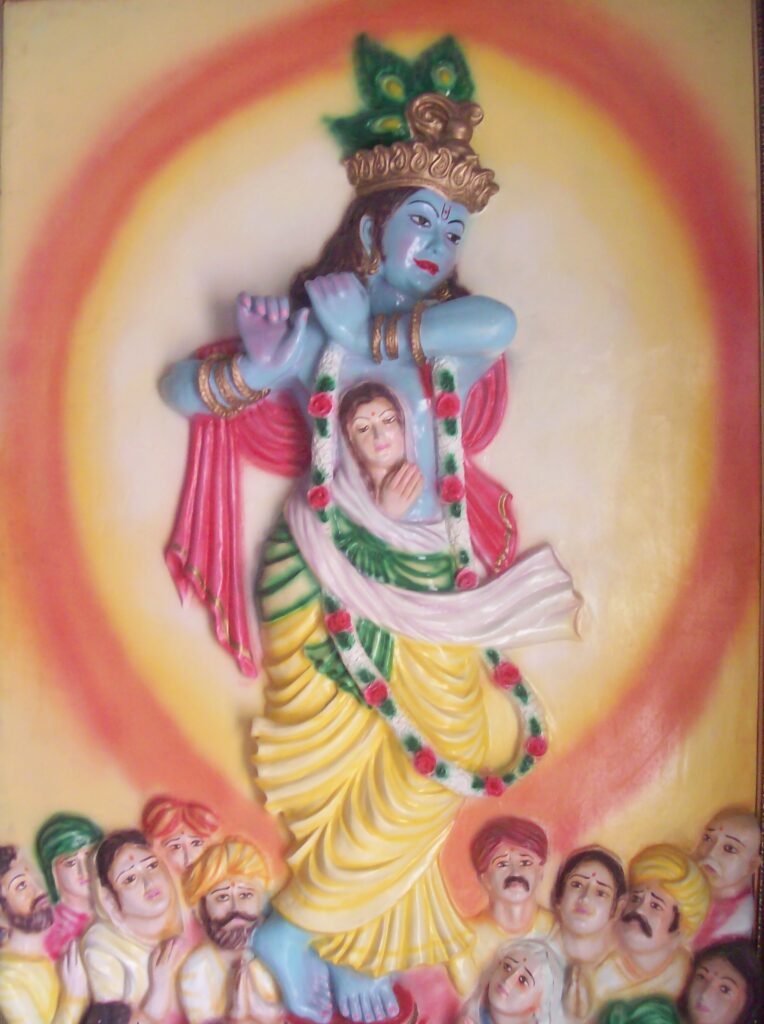
Meerabai residing in Krishna’s heart, a mural in Merta fort, Merta, Rajasthan
In Maharashtra, the Bhakti movement totally circled around Vithoba of Pandharpur. Saints like Dnyaneshwara, Tukaram, Eknath, namdev and many others wrote extensively about Vitthala. Even today, annually a foot pilgrimage is carried out from hometown of 100s of saints, to Pandharpur. Rajasthan’s Bhakti movement is characterised by the compositions by Mirabai, the princess of Merta and daughter in law of Chittorgarh, who dedicated her life to Krishna. In Gujarat, Narsi Mehta is seen as the flagbearer of the Bhakti movement.
In recent times, the Bhakti movement has gone international with emergence of ISKCON, an organisation dedicated to devotion to Krishna. If we go through all these reference, we can see that the worship of Krishna in various forms has been very influential in the Bhakti movement.
Why we get more influenced by Krishna?
Among all the incarnations of Vishnu, Krishna finds most reverence. What may be the reason, I often wonder.
Is it because he is the perfect child? The notorious, yet adorable; ruckus causing but smart enough to save the village by outside ruckus. Krishna the child evokes the emotion, which many famous poets and saints have latched on to as the runway to Bhakti. It is easy to love a child, unreservedly. It is the kind of love that all paths of devotion in all religions seek. With Krishna it is so easy to love such a child, who does not judge, does not preach, does not seem better than you.
As a young boy, Krishna is a charmer. He doesn’t give us serious dialogues about how devotion or love should be. He just accepts all the love that comes towards him. And he gives love back to everyone. And the charm is not limited to the lover side of him. It is also affluent in the way he manages conflicts with his charm. It is about how brings together all the villagers to face the wrath of Indra, the charm with which he makes his mom happy, the charm with which he makes his place in the Pandavas, and the same charm he uses as a statesman. In today’s age, where influence is one of the biggest asset, Krishna is a template.
Krishna plays multiple roles in his life. He is lover for Goopis, friend for Draupadi, son for Yashoda, warrior enemy for Kansa, philosopher and guide for Arjuna, a trainer for Bhima and Duryodhana (not many know about this). But while playing all these roles, he always maintains his human side. Except in Bhagavad Gita, he nowehere mentions about him being incarnation of Vishnu. He never talks about anything divine about himself. There is always a human element to his actions and adventures. He is a cowherd. Not some princely aristocrat. Krishna often finds himself in questionable ethical situations and challenges our sense of righteousness. ‘Do the ends justify the means?’ we are constantly left to wonder. There is never a right answer to a complex human problem. Krishna shows us how to see this and work our own way through it. There is no silver bullet.
Krishna’s life never played according to the rulebook. He does not always follow the rules, but does not break them either. What he does, it finding a golden mean. He gets his means, without directly breaking the law. Something, we all often desire to do. Krishna does not tell us to be always right. He teaches us that it is ok to do wrong, with those who do not do right. Krishna, like every other deity, talks of Dharma. But Krishna tells us that Dharma is a way of living life, not a way of achieving your goal. And the language of Dharma is good only for those, who themselves uphold Dharma in the highest regard. Krishna, in his life, faces a lot of situations that we may face in our lives. And that’s why, Krishna’s actions find more relevance to actions in our lives. No wonder we find Krishna more close to our hearts and our lives. And no wonder, the saints and poets in the Bhakti tradition chose Krishna as perfect deity to connect us the world of divine.
